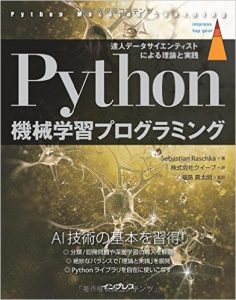PYTHONで学ぶ機会学習
【講義概要】
機械学習とは、データから学習した結果をもとに、新たなデータに対して判定や予測を行うことです。すでにさまざまな機械学習の方法が開発されています。
本講義では、そうした方法について背景にある理論や特徴を解説した上で、Pythonプログラミングによる実装法を説明していきます。
初期の機械学習アルゴリズムから取り上げ、終盤ではディープラーニングについても見ていきます。機械学習の理論と実践についてバランスよく解説し、AIプログラミングの第一歩を踏み出すためのガイドを行います。
【テキスト】
「Python機械学習プログラミング 達人データサイエンティストによる理論と実践」
Sebastian Raschka (著),
株式会社クイープ (翻訳),
福島真太朗 (翻訳)
単行本(ソフトカバー): 456ページ
出版社: インプレス (2016/6/30)
言語: 日本語
ISBN-10: 4844380605
ISBN-13: 978-4844380603
発売日: 2016/6/30
【テキストの内容紹介】
・機械学習の各理論を説明し、Pythonプログラミングによる実装が解説されています。
・初期の機械学習アルゴリズムから、深層学習の導入までを見ていきます。
・原著『Python Machine Learning』は米国Amazon.comでベストセラーです。
・Data Modeling & Design/Data Processing/Neural Networksの3つのカテゴリーで首位(2016/5/24時点)
■「はじめに」より抜粋
機械学習の実務家になりたい、問題をもっとうまく解決したい、機械学習の研究者になりたい場合、本書はそのためにあります。ただし、初心者は機械学習の理論に圧倒されてしまうかもしれません。筆者が思うに、実践的なサンプルコードを使用することが重要です。実際に試してみることで、概念が明確になるからです。
筆者の使命は、これまでとは違う本を提供することです。それは機械学習の概念に不可欠な内容を取り上げ、機械学習のアルゴリズムの仕組み、それらを使用する方法、そして(最も重要な)一般的な落とし穴を避ける方法を直観的かつ有益な方法で説明することです。
【講義概要】
第1回 Pythonとは何か?
第2回 「データから学習する能力」をコンピュータに与える(第1章)
第3回 分類問題 —機械学習アルゴリズムのトレーニング(第2章)
第4回 分類問題 —機械学習ライブラリscikit-learnの活用(第3章)
第5回 データ前処理 —よりよいトレーニングセットの構築(第4章)
第6回 次元削減でデータを圧縮する(第5章)
第7回 モデル評価とハイパーパラメータのチューニングのベストプラクティス(第6章)
第8回 アンサンブル学習 —異なるモデルの組み合わせ(第7章)
第9回 機械学習の適用1 —感情分析(第8章)
第10回 機械学習の適用2 —Webアプリケーション(第9章)
第11回 回帰分析 —連続値をとる目的変数の予測(第10章)
第12回 クラスタ分析 —ラベルなしデータの分析(第11章)
第13回 ニューラルネットワーク —画像認識トレーニング(第12章)
第14回 ニューラルネットワーク
—数値計算ライブラリTheanoによるトレーニングの並列化(第13章)
第15回 まとめ
rasbt/python-machine-learning-book
Code Issues 0 Pull requests 0 Pulse Graphs
Branch: master
Switch branches/tags
Nothing to show
Nothing to show
Create new file Find file History
python-machine-learning-book/code/
Latest commit 41be07c 9 days ago rasbt add comma seperators
| .. | |||
| Failed to load latest commit information. | |||
| _convenience_scripts | full toc | 10 months ago | |
| bonus | fix init_weights | 3 months ago | |
| ch01 | upd watermark notes + links to translations | 3 months ago | |
| ch02 | upd watermark notes + links to translations | 3 months ago | |
| ch03 | upd watermark notes + links to translations | 3 months ago | |
| ch04 | upd watermark notes + links to translations | 3 months ago | |
| ch05 | update semisupervised | 27 days ago | |
| ch06 | update semisupervised | 27 days ago | |
| ch07 | math.ceil in py27 | 3 months ago | |
| ch08 | adding simpler pickle test scripts | 2 months ago | |
| ch09 | adding simpler pickle test scripts | 2 months ago | |
| ch10 | upd watermark notes + links to translations | 3 months ago | |
| ch11 | update datestamp | 2 months ago | |
| ch12 | add comma seperators | 9 days ago | |
| ch13 | upd watermark notes + links to translations | 3 months ago | |
| datasets | remove movie data duplicate | 3 months ago | |
| optional-py-scripts | pep 8 and python scripts — last part | 5 months ago | |
| README.md | softmax regression bonus notebook | 5 months ago | |
README.md
Table of Contents and Code Notebooks
Simply click on the ipynb/nbviewer links next to the chapter headlines to view the code examples (currently, the internal document links are only supported by the NbViewer version). Please note that these are just the code examples accompanying the book, which I uploaded for your convenience; be aware that these notebooks may not be useful without the formulae and descriptive text.
- Machine Learning – Giving Computers the Ability to Learn from Data [dir] [ipynb] [nbviewer]
- Training Machine Learning Algorithms for Classification [dir] [ipynb] [nbviewer]
- A Tour of Machine Learning Classifiers Using Scikit-Learn [dir] [ipynb] [nbviewer]
- Building Good Training Sets – Data Pre-Processing [dir] [ipynb] [nbviewer]
- Compressing Data via Dimensionality Reduction [dir] [ipynb] [nbviewer]
- Learning Best Practices for Model Evaluation and Hyperparameter Optimization [dir] [ipynb] [nbviewer]
- Combining Different Models for Ensemble Learning [dir] [ipynb] [nbviewer]
- Applying Machine Learning to Sentiment Analysis [dir] [ipynb] [nbviewer]
- Embedding a Machine Learning Model into a Web Application [dir] [ipynb] [nbviewer]
- Predicting Continuous Target Variables with Regression Analysis [dir] [ipynb] [nbviewer]
- Working with Unlabeled Data – Clustering Analysis [dir] [ipynb] [nbviewer]
- Training Artificial Neural Networks for Image Recognition [dir] [ipynb] [nbviewer]
- Parallelizing Neural Network Training via Theano [dir] [ipynb] [nbviewer]
Bonus Notebooks (not in the book)
- Logistic Regression Implementation [dir] [ipynb] [nbviewer]
- A Basic Pipeline and Grid Search Setup [dir] [ipynb] [nbviewer]
- An Extended Nested Cross-Validation Example [dir] [ipynb] [nbviewer]
- A Simple(r) Barebones Flask Webapp Template [view directory][download as zip-file]
- Reading handwritten digits from MNIST into NumPy arrays [GitHub ipynb] [nbviewer]
- Scikit-learn Model Persistence using JSON [GitHub ipynb] [nbviewer]
- Multinomial logistic regression / softmax regression [GitHub ipynb] [nbviewer]
Contact
I am happy to answer questions! Just write me an email or consider asking the question on the Google Groups Email List.
If you are interested in keeping in touch, I have quite a lively twitter stream (@rasbt) all about data science and machine learning. I also maintain a blog where I post all of the things I am particularly excited about.
